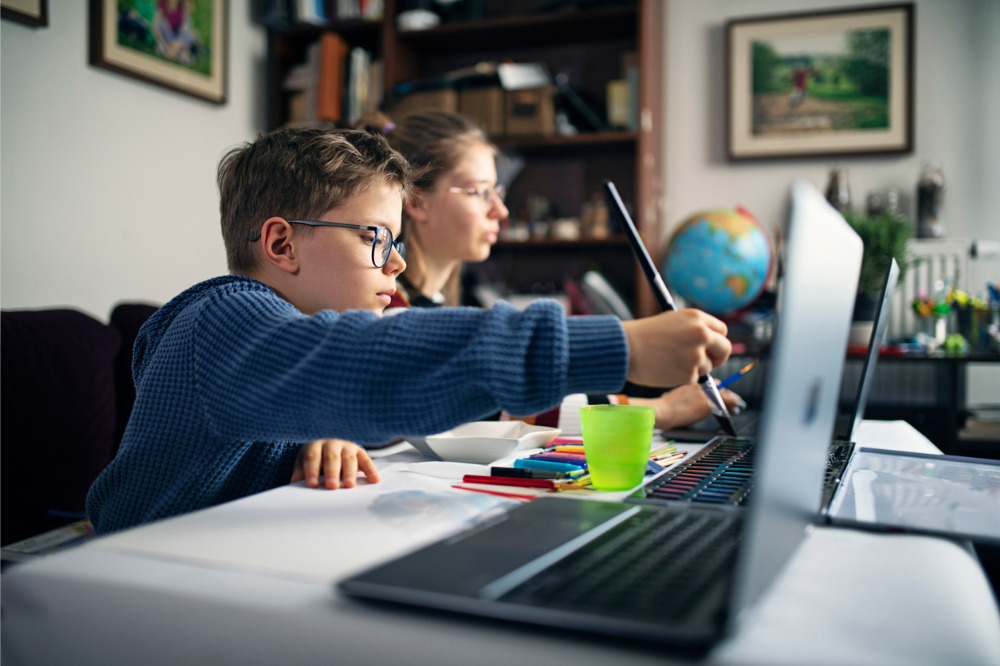
This week, almost 700,000 Victorian students learned that they will again be learning from home as of July 20.
Under the arrangements, announced by Premier Daniel Andrews on Sunday, public school students from Prep to Year 10 who live in Melbourne and Mitchell shire will undergo remote and flexible learning until August 19.
This has put the spotlight back on parents who, until three weeks ago, were breathing a collective sigh of relief as their children began to return to face-to-face teaching at school.
In May, a report found that one third of parents dedicate their entire day to their child’s remote learning and 85% of primary parents spend at least a couple of hours per day supporting their child’s at-home learning.
Dr Matthew Zbaracki, Australian Catholic University, Head of School of Education, Victoria, and Jane Plunkett, an ACU-qualified teacher turned education consultant, have two school-aged children.
They say teachers did not expect parents to run their home like a classroom.
“It’s a very stressful time for everyone. But there is a misunderstanding about teaching at home,” Dr Zbaracki said.
“To home school in the ‘purest’ sense means the parent takes on the role of being the educator, (teacher) and provides the actual curriculum and assignments and activities”.
Dr Zbaracki said what most Victorian parents are doing now is ‘home learning’.
“The tasks are provided by the school, and the parent may assist as a guide with accomplishing them,” he said.
“Home learning provides more guidance and structure for families than true home schooling”.
Dr Zbaracki said the main goal of home learning was to keep children connected with their schoolwork and engaged in age-appropriate learning activities.
“These are unprecedented times for all of us, and Victoria is trying to cope with dramatic changes to its day-to-day existence,” he said.
“It’s important that we recognise that parents will facilitate learning in very different ways and that’s OK. When teaching children at home, parents must take the pressure off themselves.”
Below, Dr Zbaracki and Plunkett share ten ways parents can ‘home learn’ with their children:
1. Set up a negotiated learning space and routine/structure.
“One of the key things that children need in these uncertain times is structure, by setting this up in the beginning, children will be better able to focus and learn and everyone involved will know the expectations,” Dr Zbaracki said.
“Make sure the children take regular breaks depending on their age.”
Plunkett added, “During the school holidays parents can use this time to become familiar with the various learning platforms that schools may require.”
2. Understand the required learning tasks.
Speak to the school and identify priority tasks. Print out the learning tasks, highlight key words, and add the due dates to your calendar.
3. Check in with your child to see how they’re doing and what they may need help with.
Parents know their child, so a common-sense approach is best. Give both yourself and your child a break from lessons when the child is showing signs of being off-task, tired or irritable.
4. Integrate movement/active time in the day (working from home parents will need this for themselves too)
“We all need to learn how to work from home and take frequent breaks,” Dr Zbaracki said. “When you take a break, get up and move around with your child, do 50 star jumps or run in place for a minute. Just like your child has a need to move and let out some energy, adults do as well.”
5. Older children also need to take ownership of their learning.
Upper primary and secondary children, who have specific projects/assignments, should know the due dates and the expectations of their teachers,” Plunkett said. “Older children need to be aware of when and how to meet these deadlines. Parents can ask prompting questions to check the child understands what is required of them.”
6. Read every day! Read with them, to them, and have them read to you!
7. Think creatively
Cooking or baking together (or with grandma or grandpa via Facetime). Make an iMovie together for an assignment for school.
8. Maintain connections with others (family, friends, classmates) by sharing books, recommending books, sharing writing.
Do this through Zoom or FaceTime so they are still able to ‘see’ their friends and family and have social interaction.
9. Never teach under a mood of frustration (yours or theirs) wait for calm and then work together.
“When the child is calm, ‘share the pen’ or ‘share the reading’ which means work collaboratively,” Plunkett said.
10. Be flexible
With the many distractions at home, parents need to be flexible with their expectations of their child’s behaviour. Children are not working with their regular classroom teacher or with their classmates, how they work will be different at home. Assignment outcomes will look different as well, but the goal is to keep children connected and engaged through learning.
Plunkett added, “Being flexible with your children at home is very important. Home learning can be a fun way to be more involved in what your child is learning.”


